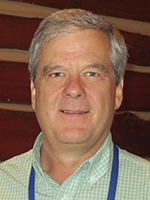
On-farm NIR moisture testers: What’s new and what’s exciting? (Dave Taysom & Dr. John Goeser)
Click here to download Taysom’s PowerPoint presentation. Click here to download Goeser’s PowerPoint presentation.
 With Dave Taysom, Dairyland Laboratories, Inc., and Dr. John Goeser, Rock River Laboratory, Inc.
With Dave Taysom, Dairyland Laboratories, Inc., and Dr. John Goeser, Rock River Laboratory, Inc.
Dairyland Laboratories, Inc. was established in 1958 and currently has four locations, serving more than 20 countries. Dave Taysom, Dairyland Laboratories director, explained the company’s role with on-farm near infrared (NIR) technology. (Click here to learn more about NIR technology.)
“Dairyland does not own or sell any instruments,” explained Taysom during his presentation at the Vita Plus Custom Harvester Meeting. “We collaborate with NIR instrument manufacturers in building calibrations for specific applications.”
One new technology Taysom highlighted was the HarvestLab™ Sensor, which is patented by ZEISS, a leader in the optics industry, with an exclusive partnership with John Deere.
The sensor is installed on the chopper spout to measure moisture and constituent values of forage in real time. With this technology, no in-field calibration of the sensor is necessary.
According to Taysom, some advantages of using this sensor for silage testing for include:
- More frequent and convenient sampling
- Real-time detection of changes in feed and silage quality
- Improved system for managing variations in feedstuffs
- Indication of quality differences between different corn varieties
- Improved silage quality through optimization of ensiling process
- Potential for savings
The HarvestLab is available for purchase at any John Deere dealership. The price ranges from $18,000 to $25,000.
 Dr. John Goeser, Rock River Laboratory, Inc., continued the discussion of new trends in on-farm NIR technology.
Dr. John Goeser, Rock River Laboratory, Inc., continued the discussion of new trends in on-farm NIR technology.
Goeser focused on the new technology of the Digi-Start Moisture Tracker™, which is a handheld moisture tracking unit. Goeser stressed that the “results are only as good as the sample that is taken.”
The instrument needs to be calibrated and reset daily to correctly read samples. Temperature fluctuation, changes in the environment, etc. affect how a feed sample is read.
Examples of on-farm situations where this NIR tool excels include:
- Environment allows for uniform sampling
- Instrument has been calibrated properly
The situations where the NIR instrument is not the best include:
- Users have not been properly trained on device operation
- Samples are inconsistent
The bottom line, according to both Goeser and Taysom, is that agricultural technology will continue to develop. For a producer or custom harvester, understanding and growing with the changes will help advance the herd and the business.
| Category: |
Equipment Forage Foundations |

